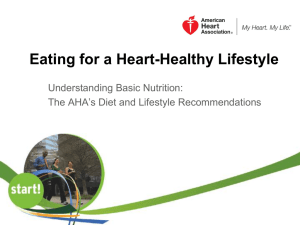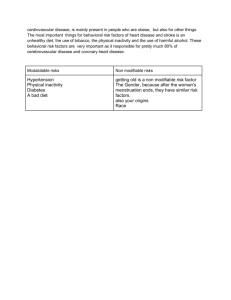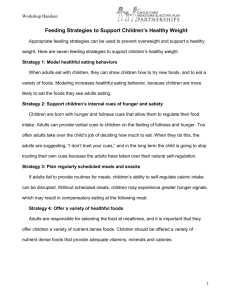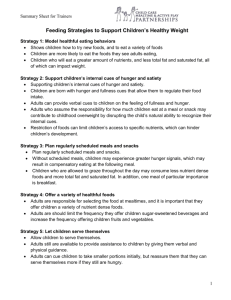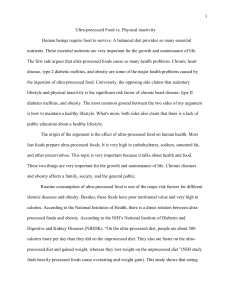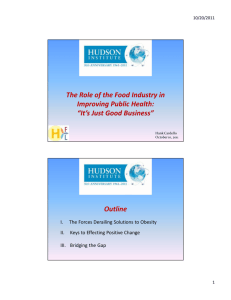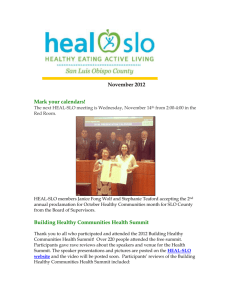Executive summary - World Health Organization
advertisement
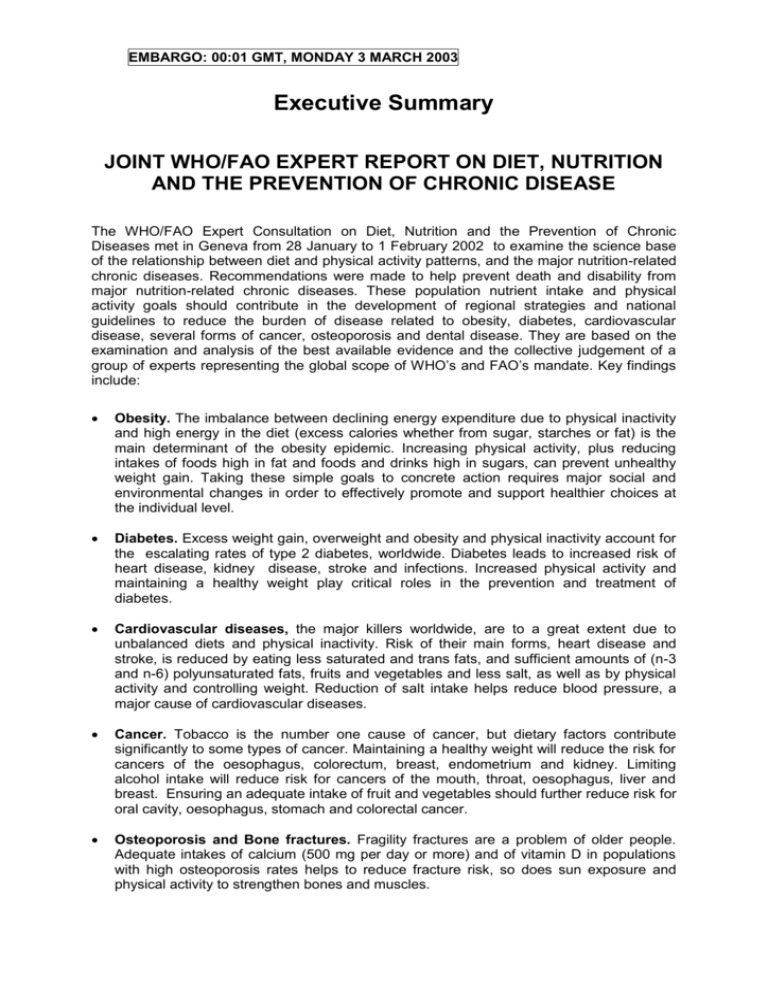
EMBARGO: 00:01 GMT, MONDAY 3 MARCH 2003 Executive Summary JOINT WHO/FAO EXPERT REPORT ON DIET, NUTRITION AND THE PREVENTION OF CHRONIC DISEASE The WHO/FAO Expert Consultation on Diet, Nutrition and the Prevention of Chronic Diseases met in Geneva from 28 January to 1 February 2002 to examine the science base of the relationship between diet and physical activity patterns, and the major nutrition-related chronic diseases. Recommendations were made to help prevent death and disability from major nutrition-related chronic diseases. These population nutrient intake and physical activity goals should contribute in the development of regional strategies and national guidelines to reduce the burden of disease related to obesity, diabetes, cardiovascular disease, several forms of cancer, osteoporosis and dental disease. They are based on the examination and analysis of the best available evidence and the collective judgement of a group of experts representing the global scope of WHO’s and FAO’s mandate. Key findings include: Obesity. The imbalance between declining energy expenditure due to physical inactivity and high energy in the diet (excess calories whether from sugar, starches or fat) is the main determinant of the obesity epidemic. Increasing physical activity, plus reducing intakes of foods high in fat and foods and drinks high in sugars, can prevent unhealthy weight gain. Taking these simple goals to concrete action requires major social and environmental changes in order to effectively promote and support healthier choices at the individual level. Diabetes. Excess weight gain, overweight and obesity and physical inactivity account for the escalating rates of type 2 diabetes, worldwide. Diabetes leads to increased risk of heart disease, kidney disease, stroke and infections. Increased physical activity and maintaining a healthy weight play critical roles in the prevention and treatment of diabetes. Cardiovascular diseases, the major killers worldwide, are to a great extent due to unbalanced diets and physical inactivity. Risk of their main forms, heart disease and stroke, is reduced by eating less saturated and trans fats, and sufficient amounts of (n-3 and n-6) polyunsaturated fats, fruits and vegetables and less salt, as well as by physical activity and controlling weight. Reduction of salt intake helps reduce blood pressure, a major cause of cardiovascular diseases. Cancer. Tobacco is the number one cause of cancer, but dietary factors contribute significantly to some types of cancer. Maintaining a healthy weight will reduce the risk for cancers of the oesophagus, colorectum, breast, endometrium and kidney. Limiting alcohol intake will reduce risk for cancers of the mouth, throat, oesophagus, liver and breast. Ensuring an adequate intake of fruit and vegetables should further reduce risk for oral cavity, oesophagus, stomach and colorectal cancer. Osteoporosis and Bone fractures. Fragility fractures are a problem of older people. Adequate intakes of calcium (500 mg per day or more) and of vitamin D in populations with high osteoporosis rates helps to reduce fracture risk, so does sun exposure and physical activity to strengthen bones and muscles. 2 Dental disease. Caries is preventable by limiting the frequency and amount of consumption of sugars and by appropriate exposure to fluoride. Erosion of teeth by dietary acids in beverages or other acidic foods may contribute to tooth destruction. The crucial role of physical activity as part of nutrition and health was acknowledged. Physical activity is a key determinant of energy expenditure, and thus fundamental to energy balance and weight control. The beneficial effects of physical activity on the metabolic syndrome are mediated by mechanisms beyond controlling excess body weight. Physical inactivity is already a major global health risk and is prevalent in both industrialized and developing countries, particularly among the urban poor in crowded mega cities. Measures and policies required to promote healthier food consumption patterns and facilitate a physically active life share common grounds and are mutually interactive in determining healthier behaviors. Healthy diets and physical activity are key to good nutrition and necessary for a long and healthy life. Eating nutrient dense foods and balancing energy intake with the necessary physical activity to maintain a healthy weight is essential at all stages of life. Unbalanced consumption of foods high in energy (sugar, starch and/or fat) and low in essential nutrients contributes to energy excess, overweight and obesity. The amount of the energy consumed in relation to physical activity and the quality of food are key determinants of nutrition related chronic disease. Not all fats are the same, it pays to know the difference. The scientific complexities of these issues should not obscure the simple messages required to orient and guide consumers. People should eat less high-calorie foods, especially foods high in saturated or trans fats and sugar, be physically active, prefer unsaturated fat and use less salt; enjoy fruits, vegetables and legumes; and select foods of plant and marine origin. This consumption pattern is not only healthier but more favourable to the environment and sustainable development. To achieve best results in preventing nutrition-related chronic diseases, strategies and policies should fully recognize the essential role of both diet and physical activity in determining good nutrition and optimal health. Policies and programmes must address the need for change at the individual level as well as the modifications in society and the environment to make healthier choices accessible and preferable. In communities, districts and nations in which widespread, integrated interventions have taken place, dramatic decreases in NCD-related death and disability have occurred. Successes have come about where people have acknowledged that the unnecessary premature deaths that occur in their community are largely preventable and have empowered themselves and their civic representatives to create health-supporting environments. This has been achieved most successfully by establishing a working relationship between communities and governments; through enabling legislation and local initiatives affecting schools and the workplace; involving food producers and processing industry. Beyond the rhetoric, this epidemic can be halted – the demand for action must come from those affected. The solution is in our hands. This report is only the first step in a process that includes consultations with governments, as well as other public and private sector stakeholders in all geographic regions, to culminate in the formulation of a Global Strategy on Diet, Physical Activity and Health, to be considered by the World Health Assembly in 2004. 2

